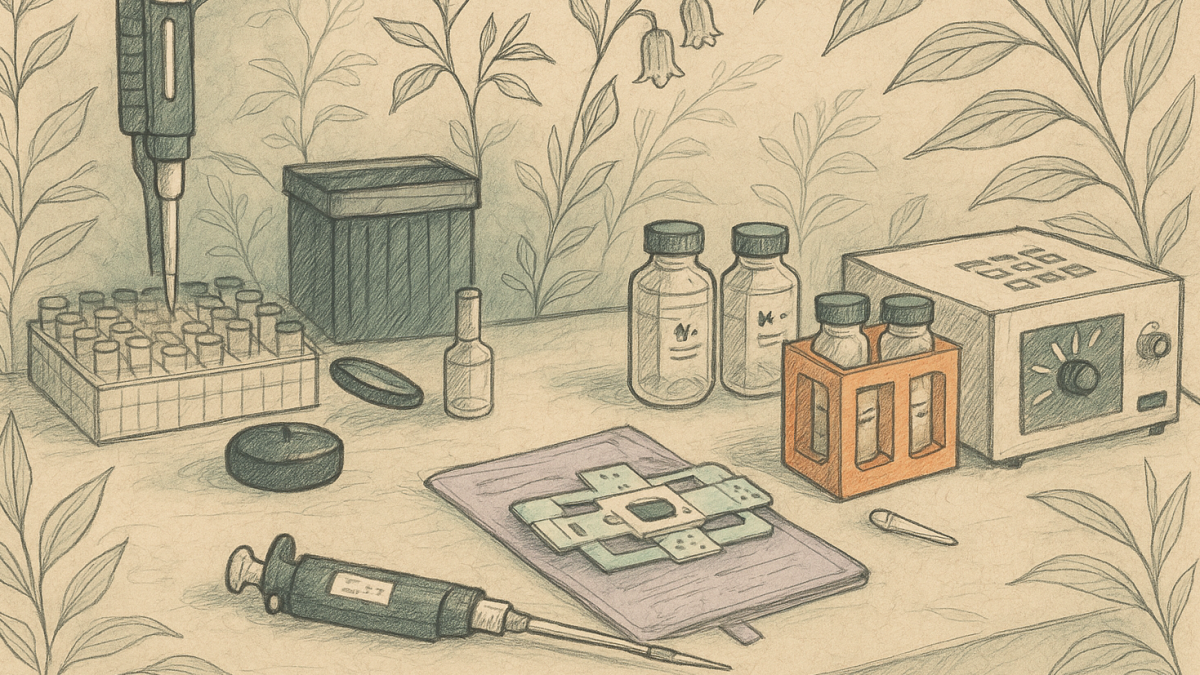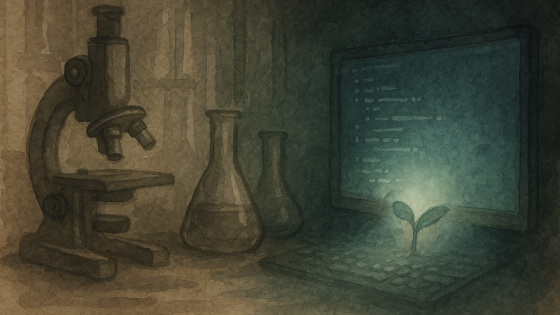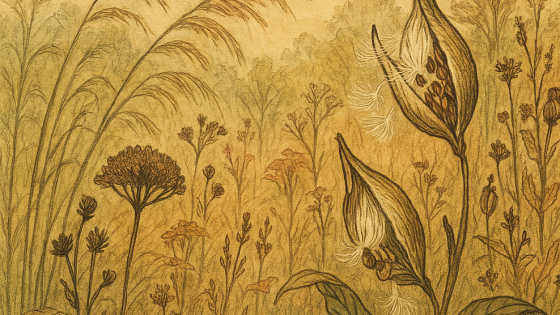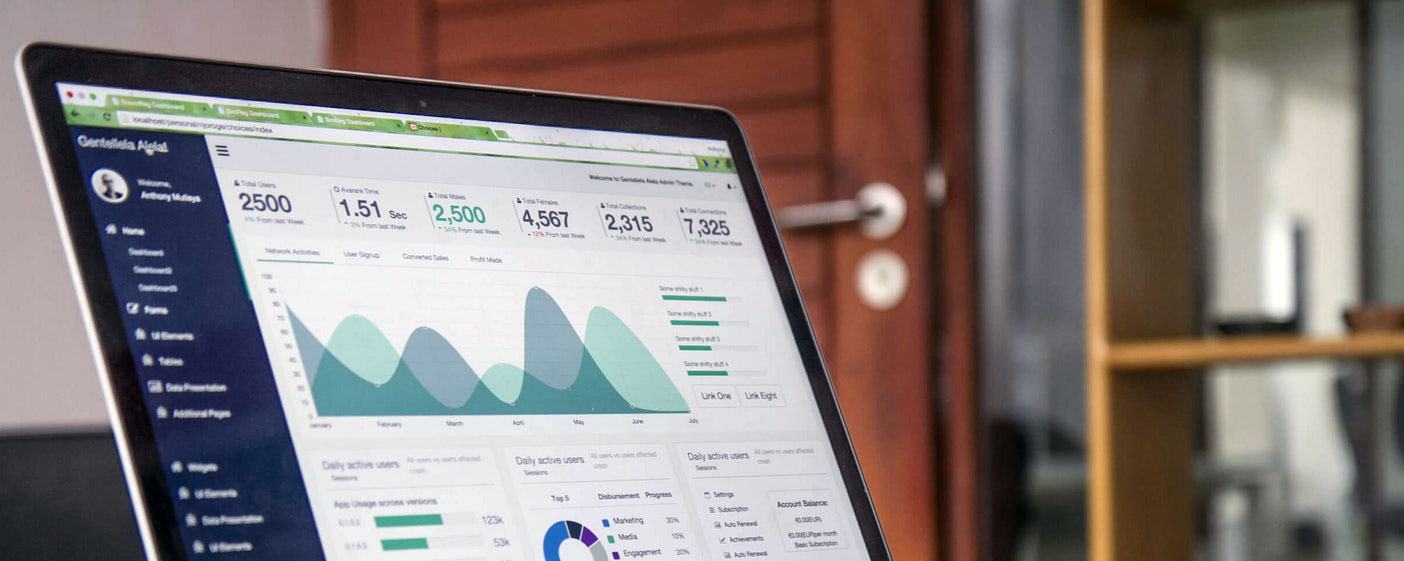The Garden of Curiosity: Why I Started This Blog

Childhood wonder sparked my path into science, art, and storytelling. This blog is where curiosity grows wild and science becomes deeply human.
In a world not so different from yours, there lived a curious child who believed trees could speak. This child wasn't content with merely admiring their towering presence or the rustle of their leaves in the breeze. No, this child pressed stethoscopes against their ancient trunks, ears straining to hear the secret symphony flowing within.
That child was me, Rosalie, and I was listening to stories that trees had been telling for centuries, though few had bothered to hear them.
"What's that sound?" I would whisper to myself, as the faint murmurs of sap coursing through hidden channels reached my ears. I didn't have fancy words like "vascular flow" or "xylem pressure" back then. I simply knew these gentle giants were alive! Breathing, growing, communicating, in my own backyard in the woods of New Hampshire and I desperately wanted to understand their language.
That sense of wonder never abandoned me as I grew. Instead, it flourished like a well-tended garden, branching into twin passions for both art and science. These weren't separate paths but rather intertwining vines climbing toward the same light.
My journey led me through magnificent spaces that would have dazzled even the most jaded explorer. Advanced research laboratories where microscopes revealed universes in miniature, university classrooms where ideas pollinated minds, and glass workshops where art and science melted together in glorious fusion. All more stories for another time.
At UC Davis, I earned my Ph.D. studying what might seem, to the casual observer, an unremarkable process: how plant cells divide and build walls from the inside out during growth. But oh, what a marvel it truly is! Imagine the most precise architectural feat you've ever witnessed. Now shrink it down a thousand times, make it self-assembling, and realize that without this microscopic miracle, life as we know it wouldn't exist.
It was like discovering that the most beautiful cathedral in the world was being built by invisible hands, one perfect brick at a time.
The Enchanted Laboratory
But it was at MIT that my story took its most magical turn. There, in laboratories that hummed with possibility, I worked on plant nanobionics! A field so extraordinary it even now sounds like something conjured from a dream.
Picture plants that glow like fireflies in the night, spinach leaves that can detect explosives, and sensors so tiny they make a grain of sand look like a mountain. This wasn't science fiction; this was science fact, unfolding beneath my fingertips daily.
As I explained these wonders to wide-eyed visitors who had never peered through a microscope or considered that plants might do more than simply grow, something remarkable happened. I discovered that the joy of scientific discovery is magnified when shared, like a light that grows brighter rather than dimmer when passed from one torch to another.
The technical language of science, once a barrier, became in my hands a bridge, connecting complex concepts to everyday understanding through stories, metaphors, and hands-on experiences that made the invisible visible and the incomprehensible clear.

The Heart Behind This Blog
Since then, I’ve sown seeds of curiosity that have blossomed into experiences where science flourishes in the most surprising corners. I've created animations where cellular processes dance across screens, taught university courses where questions matter more than answers, led garden tours where every leaf tells a story, mentored young scientists finding their own paths, and designed interactive experiences where art and science intertwine like DNA strands.
Whether decoding data from cannabis/hemp crops or building tactile models of plant cells that hands can explore when eyes cannot see, my purpose remains constant: to make science not feel like a distant mountain to be climbed but like a wondrous forest to be explored together. When someone understands the world around them. When we engage with our world and open up science in ways that feel real and memorable. No one can take that away.
An Invitation to the Garden
I believe science isn't merely a field of study reserved for those with specific talents or training. It's the language of curiosity, the first language we all speak as children when we ask "why" and "how" and "what if." And like any good language, it should welcome all speakers, regardless of their accent or fluency.
So if you've wandered into this garden of mine, whether you're a fellow scientist, a teacher seeking new ways to inspire, or simply someone who remembers what it was like to press your ear against a tree and wonder what stories it might tell, you've found a place where curiosity is cultivated and wonder never ceases.
Let's grow something extraordinary together.
The Seeds I Sow
Every story I share in this garden is rooted deeply in scientific truth, but nurtured with imagination and heart. I use storytelling not to simplify science but to reveal its inherent beauty like clearing away undergrowth to expose the magnificent structure of an ancient tree.
To me, making science accessible isn't about reducing its complexity but about creating multiple pathways to understanding. It's like offering different maps to the same treasure, some visual, some tactile, some narrative—so that everyone can find their way regardless of how their mind works.
When we open up science in this way, we discover connections we never imagined possible, between disciplines, between people, between ways of knowing the world.
A Garden for All Senses
At its heart, Growing Connections springs from a simple truth that took me years to understand we all experience the world differently, and true learning happens when we engage not just our minds but our entire beings.
Traditional science education often resembles a formal garden with straight paths and labeled specimens: read this, memorize that, observe this diagram, listen to this lecture. But what about those whose minds flourish in wilder landscapes? Those who learn by touching, building, listening, moving, or even tasting?
That's where magic happens! when science and art intertwine like vines around a trellis. We engage in all senses and suddenly, understanding blooms in unexpected places.
I find inspiration in remarkable pioneers like Dr. Wanda Díaz-Merced, a blind astronomer who transformed astronomical data into sound, allowing her to "hear" patterns in the stars that sighted researchers had missed. Her work reminds me that designing with accessibility isn't about accommodation, it's about innovation that benefits everyone.
The Wonders Awaiting You!
Secret Chronicles of Plant Cells
In this corner of my garden, you'll discover how plants (those seemingly silent companions of our world) perform feats of engineering and chemistry that would make the most brilliant human inventors green with envy.
Did you know that plants can "hear" water, "taste" light, and "talk" to each other through underground fungal networks? Or that they solve complex mathematical equations to manage their resources? Even scientists who have studied plants for decades find themselves astonished by new discoveries almost daily.
I'll guide you through these microscopic marvels with stories that make cellular biology feel like an adventure tale because that's precisely what it is.
Sensory Exploration
Here, science transcends the page and screen to become something you can touch, hear, and experience with your whole being.
Imagine running your fingers across a 3D-printed model of a plant cell enlarged ten thousand times, feeling the intricate structures that make life possible. Or closing your eyes as the electrical patterns of photosynthesis are transformed into music, letting you "hear" how a leaf captures sunlight.
These aren't novel experiences; they're pathways to understanding that bypass traditional barriers and create connections that last because they engage not the thinking mind but the feeling body as well.
Artistic Discovery
In this luminous space, art and science dissolve their artificial boundaries to reveal the creative heart beating at the center of both disciplines.
I explore how glasswork can capture the translucent beauty of cellular structures, how digital modeling can make molecular interactions dance before your eyes, and how sculptural expression can translate abstract concepts into forms that speak directly to our innate sense of pattern and meaning.
Inspired by the breathtaking precision of the 19th-century Blaschka glass flowers, botanical models so perfect they seem alive. I showcase contemporary projects that similarly transform scientific understanding into experiences of beauty and wonder.

Why This Matters
Science shapes our world in ways both profound and intimate, from the food on our plates to the medicines in our cabinets, from the technologies we depend on to the policies that will determine our collective future.
But for science to truly serve humanity, it must belong to everyone, not just those with specific backgrounds, learning styles, or access to traditional education. That means reimagining how we share scientific knowledge, breaking down barriers of jargon and abstraction, embracing creativity as a path to understanding, and ensuring that science speaks in many languages and through many modalities.
So, I invite you to join me in this garden of wonders, to explore the astonishing capabilities of plants at scales too small for the naked eye, to discover how art can transform understanding from an abstract concept to a lived experience, and to a future where scientific learning embraces the full spectrum of human diversity.
Because when science is for everyone, the seeds of innovation fall on fertile ground everywhere, and that's how we grow a better world together.

"The most beautiful thing we can experience is the mysterious. It is the source of all true art and science."- Albert Einstein
Categories: : All, SciCom Tips
 Rosalie Sinclair
Rosalie Sinclair 



